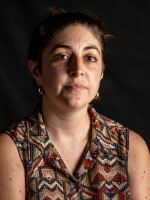It’s a quintessential summer scene. Fireflies light up the night sky while children and adults revel in their beauty, pointing at each new flickering glow. But this isn’t a public park or someone’s backyard, this is a dedicated firefly sanctuary.
“It’s dark, which is what fireflies love,” Chris Schipper, my guide for the night, says.
We put on bug spray, grab flashlights and carefully walk over tree roots and mud.
“We’re going to take a somewhat rugged trail up to it,” Schipper explains.
After a few minutes, we enter the New Canaan Land Trust Firefly Sanctuary — a meadow in southwest Connecticut filled with thousands of fireflies.
“I feel like I’m seeing fireworks, but shrunken down to the smallest size possible,” says 11-year-old Avery Gibson.
Gibson is here with her Girl Scout troop. They’re sitting on a bench at the top of the meadow wearing mosquito nets over their faces. Her friend, Aoife Dilday, also 11-years-old, says she’s learning a lot about fireflies.
“I didn’t know there were so many types of fireflies. I thought there was just a firefly,” Dilday says.
There are actually almost 2,000 species of fireflies worldwide, with 170 species found in North America, says Schipper, the former president of the New Canaan Land Trust.
The land trust’s sanctuary is 6.5 acres of meadow and forest. It has two things fireflies need: darkness and woodlands — both of which are becoming harder to find.
“The biggest challenge for fireflies is habitat,” Schipper says. “There are fewer and fewer places near big cities that are like this, completely undeveloped.”
Fireflies need darkness so they can find each other and reproduce. The flashing light they give off is actually a mating call. The female fireflies hover near the ground, flashing their lights, while the male fireflies climb up to the trees.
“They are going up to try to locate, or signal, to a female down below. And when they coordinate their signals, he will try to fly down to meet the female,” Schipper says.
From there, the females lay their eggs. The eggs hatch and the larvae spend 1-to-2 years living on the ground. It’s why pesticides, herbicides, fungicides and other chemicals pose another challenge to fireflies.
“All the things that people put down to get a great lawn, also suppress almost everything else,” Schipper says.
Maddie Norton is volunteering with the New Canaan Land Trust. She hopes that by seeing thousands of fireflies like this, people will get inspired to make small changes at home.
“Maybe you don't need your landscape lighting on all night,” Norton says. “You can turn it off at like midnight and turn it back on at like six in the morning, just like small things like that.”
Like any good day in summer, the night ends in rain. Before we head out, I ask Schipper what the future holds for fireflies.
“It’s tough. I mean, as more and more development comes, as more and more lawns get built out, as more and more people want, you know, a monoculture, there’s fewer — there’s less and less habitat. The same challenges that our birds are facing are being faced by fireflies and all different species.”
But, Schipper says, this sanctuary is a good start.
“It’s about making a gift to the future," he says, "hopefully this will be thriving in another 100, or 500, or 1,000 years. That’s the hope.”
Áine Pennello is a Report for America corps member who covers the environment and climate change for Connecticut Public.








